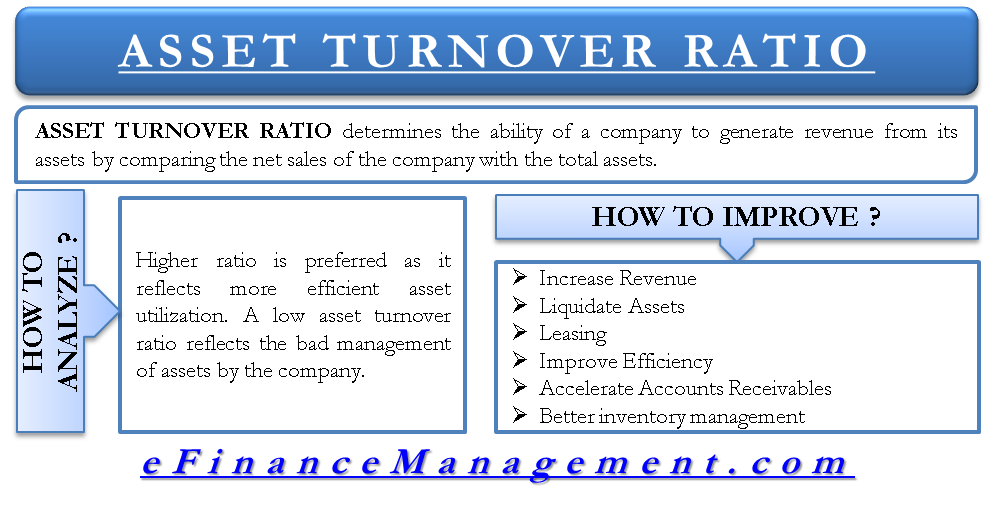The asset turnover ratio is an important financial ratio for understanding how well the company utilizes its assets to generate revenue. It is imperative for every company to analyze and improve the asset turnover ratio (ATR). The article highlights the reasons and ways to analyze and interpret asset turnover ratio as an important part of ratio analysis.
Definition of Asset Turnover Ratio
The asset turnover ratio determines the ability of a company to generate revenue from its assets by comparing the net sales of the company with the total assets. We calculate it by dividing net sales by the average total assets of a company. In other words, it aims to measure sales as a percentage of average assets to determine how much sales the company generates by each rupee of assets.
There can be several variants of this ratio depending on the type of assets considered to calculate the ratio, viz. with fixed assets, there is a fixed asset turnover ratio, and similar for current assets and total assets, capital intensity ratio which is reciprocal of this asset turnover ratio that helps in understanding it another way round.
How to Interpret Asset Turnover Ratio?

The asset turnover ratio shows the comparison between the net sales and the average assets of the company. An asset turnover ratio of 3 means for every 1 USD worth of assets and sales is 3 USD. So, a higher asset turnover ratio is preferable as it reflects more efficient asset utilization. However, as with other ratios, the asset turnover ratio needs to be analyzed while considering the industry standards.
Also Read: Asset Turnover Ratio (ATR)
Some industries are designed to use assets in a better way than others. A higher asset turnover ratio implies that the company is more efficient at using its assets. A low asset turnover ratio, on the other hand, reflects the bad management of assets by the company. As a result, it may also indicate production or management problems.
Why is it necessary to Improve Asset Turnover Ratio?
Since the asset turnover ratio measures the efficiency of a company in managing its resources to generate its sales, it is very obvious that higher turnover ratios are preferable for reflecting a better state of affairs at the company. This ratio gives insight to the creditors and investors into the company’s internal management. A low asset turnover ratio will surely signify excess production, bad inventory management, or poor collection practices. Thus, it is very important to improve the asset turnover ratio of a company.
How to Improve Asset Turnover Ratio
If a company analyzes that its asset turnover ratio is declining over time, there are several ways for improving the asset turnover ratio:

Increase in Revenue
The easiest way to improve the asset turnover ratio is to focus on increasing revenue. The assets might utilization be proper, but the sales could be slow, resulting in a low asset turnover ratio. The company needs to increase its sales through more promotions and quick movements of the finished goods.
Liquidate Assets
Obsolete or unused assets should be liquidated quickly. Assets that are not used frequently should be analyzed to see whether there is a sense in retaining those. Basically, the company should sell those assets that do not add to the bottom line regularly.
Also Read: Turnover Ratios
Leasing
Another efficient way is to lease assets instead of buying them. Any leased equipment is not counted as a fixed asset.
Improve Efficiency
The asset turnover ratio could be low because of the inefficient use of assets. The company should analyze how it uses the assets and ways to improve the productivity of each asset. The output should increase without any significant increase in any other expenses.
Accelerate Accounts Receivables
The Slow collection of accounts receivables will lower the sales in the period, hence reducing the asset turnover ratio. The company should focus on quick collection practices. This can include outsourcing the delinquent accounts to a collection agency, hiring an employee just for collecting pending invoices, and reducing the amount of time given to customers to pay.
Better Inventory Management
The company needs to check its inventory management to figure out the time spent in the movement of the goods throughout the process. If the company’s delivery system is slow, there will be delays in getting the product to the customer and collecting the payment on time. So, the company should invest in technology and automate the order, billing, and inventory systems. This will improve sales and increase the asset turnover ratio.
Conclusion
Companies need to keep track of the asset turnover ratio. This ratio helps the company to measure how productive the business is. And how much revenue investment in the assets generates? A high asset turnover ratio is a sign of better and more efficient management of assets on hand. So, the companies need to analyze and improve their asset turnover ratio at regular intervals.
Quiz on How to Analyze and Improve Asset Turnover Ratio?
This quiz will help you to take a quick test of what you have read here.


Hi Sanjay,
You did a great job with this website. I really found it easy and simple to understand.
Do you have a book of this or only the website ?
Thanks for sharing this article. This will definitely help me to manage my business well. This is a very helpful site. This will help me to improve my business Asset Turnover Ratio.
Hello Sanjay
Thank you for your website! The content is so simple and easy to apply in everyday finance tasks. I am studying accounting and wanted clear examples of financial analysis and your website is one of the best.
Again thank you for taking the time out for making finance easier to understand.
Arv
Wonderful Content Thanks for sharing.